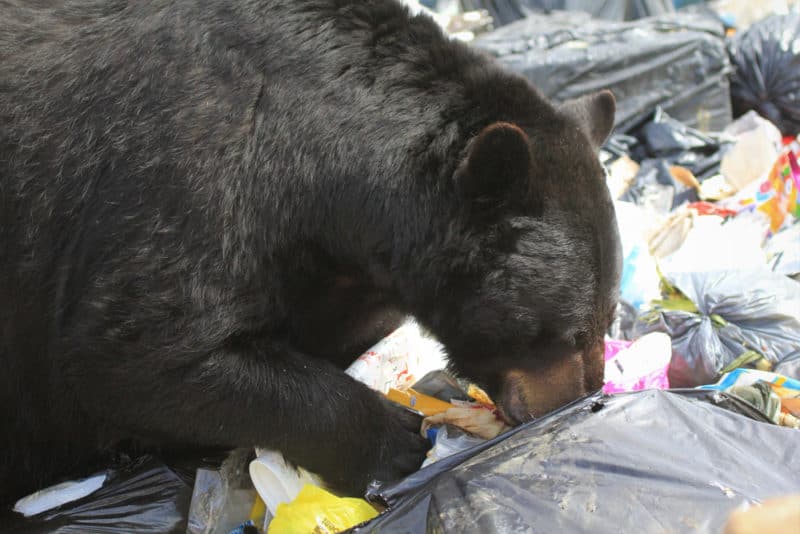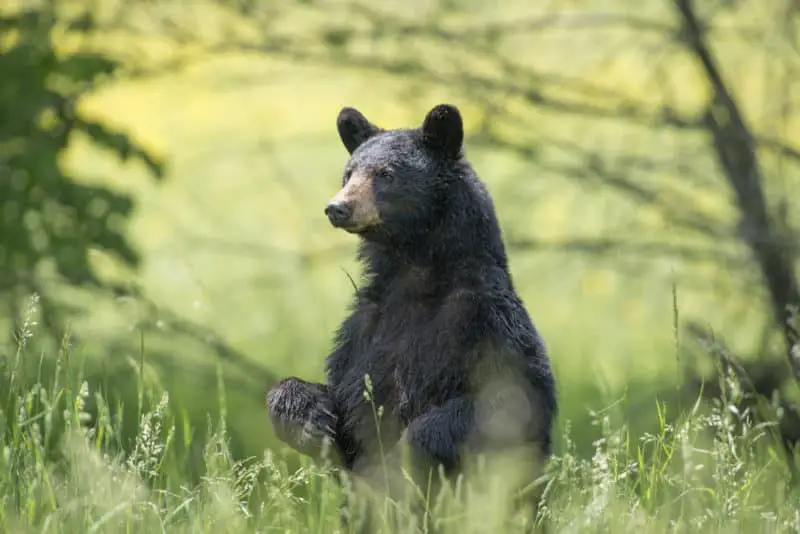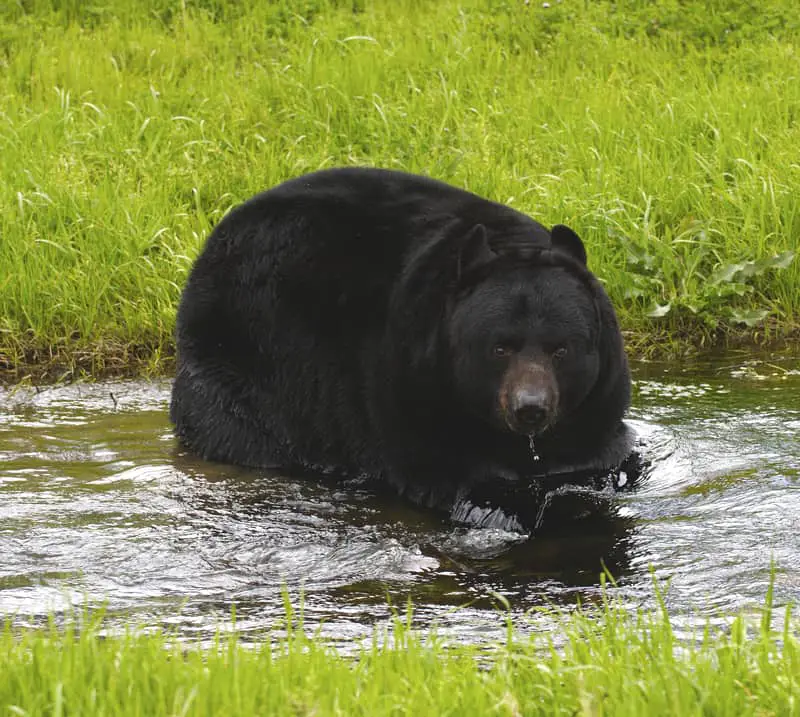The state of Florida is home to the Florida black bear (Ursus americanus floridanus). Florida black bears are one of 16 subspecies of the American black bear. They are the state’s largest mammal.
As of 2017, the Florida Fish and Wildlife Conservation Commission estimates that Florida’s black bear population is around 4,050 bears living throughout the state.
Florida black bear
Before the time of European settlement of North America, the Florida black bear ranged throughout mainland Florida and southward onto the northern keys and northward into southern Georgia, Alabama and Mississippi. However, they currently occupy only about 49% of their former range. According to a 2015 population map, the largest black bear populations in the sunshine state inhabit South Florida, central Florida, and the eastern Florida panhandle.
Most of the major black bear populations in Florida live on or near public lands such as Ocala National Forest, Big Cypress National Preserve, Apalachicola National Forest, Osceola National Forest, and Okefenokee National Wildlife Refuge. See
What do Florida black bears look like?
Florida black bears are Florida’s sub-species of the American black bear. Phenotypically, they don’t appear much different from other black bears.
Black bears are the most common and readily recognized bears in North America. Additionally, they live only in North America. The other two bear species that live on the North American continent, Brown bears, and polar bears, also live in Europe and Asia.
Adult black bears are anywhere from 50 to 85 inches long from the tip of the nose to the tip of the tail. Their average height is around 30 inches at the shoulder. Normal adult bears have a weight range that is anywhere from 140 to 400 pounds. However, adult males can be up to 70% larger than adult females, and some giant-sized individuals weigh over 800 pounds. The largest adult male black bear in Florida weighed 760 pounds, while the largest adult female black bear in Florida weighed 460 pounds.
Even though they are named black bears, their colors can vary from black, blue-grey, cinnamon, brown, and blue-black, and on infrequent occasions, a black bear can even be white. A small percentage of them are cinnamon-colored. Some black bears have a V-shaped white patch on their chest.
Southeastern black bears, including Florida black bears, are all black. They don’t have some of the color phases that are present in black bears in the western United States.
Black bears, in general, have a long brown snout, a short tail, and small brown eyes, although their eyes are blue at birth. Black bears lack the shoulder hump that brown bears or grizzly bears have. In areas that both species inhabit, the hump, or the lack thereof, is a distinguishing feature. The only species of bear in Florida is the black bear, though.
What do Florida black bears eat?
Like all black bears, Florida black bears are omnivores. This means that they eat both meat and plant material. In some cases, depending on what food is available, black bears eat a diet composed of 96% plant material and 4% meat.
Florida’s black bears eat acorns, berries, sabal palm fruits, saw palmetto, honey, bee larvae, and miscellaneous insects. They’ll also eat raccoons, armadillos, and white-tailed deer. They’re also capable of and will take down a wild boar from time to time.
Florida black bear behavior
Most of a black bear’s daily activities are governed by 1 of 2 motivators. These are, being constantly in search of food and the search for a mate.
These are mostly solitary animals, with the exception of mating and the raising of young.
Their home ranges vary in size depending on the density of potential food sources. In Florida, a male black bear will have a home range that encompasses up to 60 square miles, while a female will have a home range that covers up to 15 square miles. While these animals generally do have home ranges and will defend a food source or a mate if another bear is present, they are not overly territorial and will tolerate the presence of other bears within their home ranges.
Mating behavior
Female Florida black bears become sexually mature at 3 to 4 years of age, while males become sexually mature at 4 to 5 years of age.
Mating takes place between mid-June and mid-August. As with all black bears, though, delayed implantation takes place, and the fertilized eggs do not implant into the uterus until late November or December. Pregnant females enter their winter dens in December, and their cubs are born in January or February. They emerge from their dens in early April.
Female Florida black bears give birth every other year. The average litter size in Florida is 2 cubs. However, female black bears in the Ocala national forest have been documented to have larger litters than the state average.

How to make your property less attractive to bears
As Florida’s Human and black bear populations are both on the increase, the potential for property-damaging bear incidents is certainly there. State wildlife officials encourage Florida residents to become proactive in avoiding human-bear conflicts.
In drought years, there is a higher likelihood of human-bear conflict. Bear sightings in rural and even suburban and urban areas increase significantly in times of drought. Drought-stressed bears might wander away from ideal bear habitat into areas with higher human populations in search of an alternative food source.
Another factor that can potentially cause bears to wander is the time of year. When female bears or sows begin to kick their previous year’s cubs off in early summer, young bears, particularly young male bears, sometimes wander great distances looking to establish their own home ranges. At this time, occasionally, they wander into residential areas as they search for their own territory. Human-bear encounters seem to increase slightly in the early summer.
Besides being dangerous apex predators, bears can potentially cause significant property damage to your home and or vehicles. For example, if a black bear smells food in your parked car, it is capable of tearing the door off to get to it.
If you live in bear country, the following bear precautions will make your property less attractive to wandering bears.
Pet food
It’s a bad idea to feed your outside pets more than they can efficiently clean up before dark. It’s also a bad idea to store your pet food outside. If you store your pet food outside, keep it in a bear-proof container.
Barbeque grills
Backyard barbecue grills are bear attractors. You should clean your barbecue grill after every use and store it in a secure place. The best thing to do with your grease drippings and meat scraps is to store them in the refrigerator until garbage day and then throw them away just before the garbage truck comes.
Trash cans
You should also store your garbage cans indoors and clean and disinfect them regularly. Unsecured garbage will surely attract bears in bear country.
Compost piles
Garden compost also has the potential to attract bears. Unless you can store your compost bear-resistant container, in a safe area, you probably shouldn’t be composting in bear range.
Vehicles
Keep all food or empty containers that have had food in them out of your vehicles. Bears have a powerful sense of smell. Furthermore, as I mentioned earlier, an adult black bear is capable of bending your car door in half if it decides it wants to get inside.
Use electric fencing.
If you have a vegetable garden, a chicken coop, small farm animals, an orchard with ripe fruit, or any other outside bear attractants, you should consider using electric fencing to keep the bears at bay.
Bird feeders will attract bears.
Bears love to raid bird feeders, whether that be hummingbird feeders or ones that dispense out bird seed. They especially like the molded blocks of suet with birdseed inside.
If you live in bear country, it’s not a good idea to put out birdseed during the warmer months. Wait to feed the birds until the winter months when bears are in their winter dens.
Never feed the bears.
A huge mistake that people sometimes make is to put food out to attract bears on purpose. When you do that, you create a situation that is beyond your control.
When bears begin to associate humans with food, they lose any fear of humans that they might have had. They also might act out aggressively if they decide that you’re not giving them the food that they want and are accustomed to. They might also take that frustration out on your neighbor or, worse yet, your neighbor’s children. Look at the article found here for an example of what I’m talking about.
The best way to make a wild bear into a nuisance bear is to feed it. When a bear decides it’s easier to forage on human foods rather than natural foods, the chances increase that it will have to be euthanized because it poses a danger to humans.
Here’s a quote from the Florida Fish and Wildlife Conservation Commission website. “Remember, a fed bear is a dead bear.”.

Are Florida black bears dangerous?
Black bears take in a large percentage of plant material compared to the meat they eat. They are the least predacious of all North American Carnivores. What’s more, most of the time, they are trying hard to avoid any contact with humans. What’s more, most of the time, when you see a black bear in the woods, they seem ponderous and lumbering and almost friendly.
However, black bears are strong, quick, and agile. They can run up to 35 miles per hour and are strong enough to peel the doors off your car. The sobering part is that no matter how friendly and inquisitive they look, black bears kill at least one person in North America each year. These attacks are mostly predatory in nature, and the responsible bear in these cases is usually a lone male that is trying to pack on fat for the coming winter.
According to the Florida Fish and Wildlife Commission, there have never been any predatory black bear attacks in the state. However, people have been bitten, and or scratched by bears defending themselves, their young, or a food source.
What if I come upon a bear in the woods?
- If you come upon a black bear in the woods, the chances are very good that as soon as it recognizes you as a human, it will be gone. However, this isn’t the case 100% of the time so if the bear hasn’t noticed you yet, try to quietly back out of the area.
- If the bear has noticed you and isn’t running away, make yourself look as large as you can and talk quietly to the bear as you slowly back out of the area. If the bear stands on its hind legs, this isn’t aggressive behavior. It is gaining some elevation in order to see you better.
- If a bear feels threatened, it may paw the ground, huff, moan, pop its teeth, or even make bluff charges in your direction if this is happening, do not turn your back on it and run. It will easily catch you.
- As your backing up, you’re keeping a close eye on the bear but avoiding direct eye contact, as locking eyes may be perceived as a sign of aggression. If the bear charges, stand your ground. The bear will catch you if you decide to run anyway.
- As the bear charges towards you, stop backing up. Instead, stand your ground and act aggressively toward the bear. This might entail waving your arms or yelling. A bear that makes vocalizations and bluff charges is trying to move you out of the area rather than eat you.
- Playing dead with a defensive Grizzly bear might save your life. However, regardless of what is motivating the bear, you should never play dead with a charging black bear. The defensive bluff-charging bear will likely eventually decide you’re not a threat and allow you to back out of the situation. On the other hand, the predatory bear would appreciate you playing dead so that it can more easily eat you.
- If you’re dealing with an aggressive black bear, you need to be mentally prepared to aggressively defend yourself with whatever weapons that are close by, whether that be rocks or sticks or even your fists.
SIGNS OF A PREDATORY BEAR
If you come across a bear acting in a predatory manner, you can expect to see any or all of the following behaviors.
1-Not defending anything
A predatory bear isn’t interested in moving you out of the area. It’s not defending a food source or cubs.
2-Acting very interested in you
A predatory bear is often recognized when it appears to be intensely interested in you or deliberately approaches you.
3-Does not display stress behaviors
A predatory bear comes up to you WITHOUT displaying any stress signals (like moaning, woofing, jaw popping, or paw swatting).” See
Florida black bear hunting
Florida does not have a regulated bear hunting season at this time. The state had a yearly bear hunt from 1936 through 1994, after which time it was closed. They again ran a limited bear hunt in 2015 but have not reopened the hunt since then.
The 2019 Florida bear management plan indicated that controlled hunting was still an effective bear population management option, but since 2015, that tool has not been utilized in the state.
Recent Posts
The only venomous snakes in Washington State are Northern Pacific Rattlesnakes. The Northern Pacific Rattlesnake (Crotalus oreganus oreganus) is a sub-species of the Western Rattlesnake. Anyone...
Skunks are not classified as true hibernators. But they go into a state of torpor when the weather gets cold. Skunks are light sleep hibernators, along with opossums, bears, and raccoons. ...

